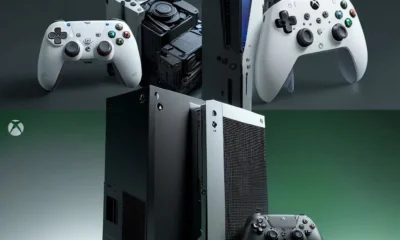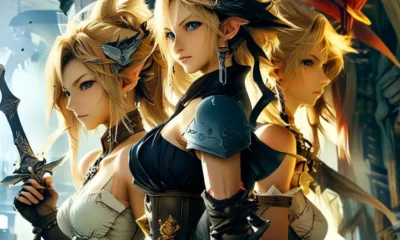Features
The Best Games of 2019
Best Video Games of 2019: Part Two
Well folks, we’ve spent the past few weeks arguing about our favourite games of the year. Now that we are done with our squabbling, the result of our top ten games debate can be found below.
There was a veritable barrage of excellent games released this year, but we’re very happy with the way the list came out, and we couldn’t be prouder of the wide-ranging, exemplary titles that our team selected. We hope you will be as satisfied with the list as we are.
10) Pokemon Sword and Shield
The Pokémon series has always been notoriously slow to evolve, making the franchise’s first main-series foray onto a home console that much more remarkable. A brilliant balancing act between strikingly new, clever iteration, and careful retention of the core DNA of the series, Pokémon Sword and Shield are not only solid games, but comfortably in contention for the title of best Pokémon titles to date. From the outset, Sword and Shield are an unrivaled realization of the Pokémon world, replete with wild, roaming pokémon rife with personality, rich environmental detail like never before, and clever new creature designs to delight and charm. Cozily blanketed beneath are all of the familiar elements that make up a Pokémon game: three starter pokémon, a rival, and a journey to become a Pokémon Master with a regionally appropriate sports slant.
The new Galar region is a fascinating juxtaposition of vividly detailed traditional routes teeming with previously unseen monsters, brought to life by the visible roaming pokémon, while still maintaining random encounters if sought after, and the new Wild Area, which gives a taste of an open-world Pokémon game. Positively brimming with ever-changing varieties of monsters, the Wild Area contains some of Sword and Shield‘s most novel elements: immense quantities of pokémon that vary by a wide range of weather conditions, a long-missing sense of danger as players encounter treacherous monsters too powerful to be caught, and new multiplayer Max Raid Battles featuring the integral Dynamax mechanic. Max Raid Battles, which operate like boss battles against massive pokémon with upwards of four players, offer multiplayer connectivity unlike anything in Pokémon thus far, and culminates in a brilliant endgame chase to catch some rare variants of new and popular pokémon, alongside peers.
Dynamax itself proves far more dynamic than Sun and Moon’s Z-moves, bringing an unexpected level of strategy capable of turning the tides of the battle, while being kept within a limited context and not limiting the transformative feature to a few capable creatures like Mega Evolution did in the X and Y era and on. Sword and Shield also come equipped with countless quality of life improvements, making this journey the most user-friendly to date, and eliminating almost all monotony. Pokémon Sword and Shield, with a vibrant, seemingly living world, ease of use, and welcome new mechanics, is the brilliant realization of many fans’ childhood dreams of a full-fledged, home console Pokémon title. (Tim Maison)
9) The Outer Worlds
There are few premises in gaming as enticing as space exploration. From Mass Effect to No Man’s Sky, the prospect of traversing the cosmos and encountering strange planets and lifeforms has been ripe with exciting game design possibilities for decades. Now, ahead of Bethesda’s long-awaited Starfield, the original creators of Fallout have delivered the best space exploration game to date, bar none.
The Outer Worlds doesn’t just succeed because it allows players to lead a ragtag crew on adventures across a meticulously designed galaxy, but also because it’s less ambitious than its contemporaries. There’s no open world, quest lines are on the shorter side, and an average playthrough only takes about 20-25 hours. Thanks to budgetary constraints, however, Obsidian was able to create an experience that feels much more lovingly crafted than anything on a massive scale.
Of course, make no mistake — The Outer Worlds is as much a hardcore role-playing game as any other. Players roll stats like Charm and Perception from the outset, and can heavily customize character traits throughout. Party members come in the form of recruitable crewmates who consistently steal the show with top-notch dialogue and strong VA performances across the board. The story itself is enthralling, but less because of its overarching narrative and more because of the absolutely brilliant character writing (I’m looking at you, Parvati) and world-building. One of Obsidian’s greatest strengths has always been its writing room, and The Outer Worlds only adds to that reputation.
In a year of some truly innovative new entries in the genre, The Outer Worlds feels like a warm blanket of familiarity. Its format is classic, but its execution is nearly flawless. Its scope is limited, but that allows for a more intimate cast and overall adventure. The allure of space — and the pitfalls of capitalism — has never felt so strong. (Brent Middleton)
8) Death Stranding
2019 has been a banner year for gaming. With some excellent original properties making their debuts and a ton of great sequels, there’s been something for everyone, and a lot of it. Still, with all of these amazing games to play, one that stands out is Death Stranding.
For the first (and possibly last) time, Hideo Kojima has been given a total carte blanche of creative freedom and financial resources to make whatever game he wanted. With Sony footing the bill, Death Stranding is maybe the most Kojima game ever made. Unfortunately, like some prog rockers and experimental filmmakers, Kojima could have well done with some reigning in this time around.
Still, what makes Death Stranding stand out so much from the competition is that it really is almost nothing like anything you’ve ever played. The game is basically a delivery sim where you must cross an apocalyptic wasteland of America and battle a bunch of ghosts along the way. What caused America to fall — and where these ghosts came from — is still relatively unclear, even after all of the overwrought explanations that punctuate the end of the game.
Few games, especially in the AAA space, are able to elicit such divergent responses from their audience. Fewer still are peppered with major actors like Norman Reedus and Lea Seydoux in painstakingly rendered motion capture. For these reasons and more, Death Stranding will be debated in critical circles for years to come, and if that’s not the mark of a game that stands out, then nothing is. (Mike Worby)
7) Astral Chain
PlatinumGames has built a reputation for itself as a studio that consistently delivers frantic, fluid, fun, hyper-stylized action titles that are predictably unpredictable and not quite like anything else on the market. It comes as no surprise then that their latest endeavor, Astral Chain, supplies all of the trademarks of a Platinum title in spades, with an unprecedented twist: tandem character controls. Astral Chain foregoes Platinum’s traditional, snappy, hack-and-slash gameplay in favor of more methodical, evenly paced action allowing players to comfortably take simultaneous control of the protagonist and their interdimensional bio-weapon, known as a Legion, in order to orchestrate a stylish, synergistic symphony of an assault. Never sacrificing substance in favor of style, Astral Chain’s distinct, gripping action gameplay provides no shortage of satisfying, dynamic combat mechanics, while offering immense variability in encounters and potential player approaches to each engagement. From countering to restraining enemies a la The Empire Strikes Back, each brisk battle is an excellent exhibition of Astral Chain’s sharp controls, distinct design, and Platinum’s signature style and performance.
Like its unique gameplay hook, Astral Chain is itself simultaneously an action game and an equally satisfying detective title featuring a rookie cop in a rich, apocalyptic, neo-noir city begging to be explored. Legions’ unique abilities are as useful out of combat as they are in combat for investigation, navigation, and puzzle-solving, making exploration and side quests generally feel like enhancements to the game rather than distractions from the superb action. This is all presented in an eye-popping, playable-anime art style full of vivid colors, epic animations, and great character designs, Astral Chain looks as good as it plays, and is easily one of the best visual experiences on Switch. Everything an action game should be and unexpectedly more, Astral Chain matches the upper echelon of Platinum titles, is destined to become a fan-favorite, Switch exclusive franchise, and is easily one of the best games of 2019. (Tim Maison)
6) Devil May Cry V
If you don’t count the spin-off/reboot DMC developed by Ninja Theory, 2019 marks eleven years since we last had a proper entry in the Devil May Cry series. That’s a long time to wait for loyal fans but thankfully Devil May Cry V is a return to form and more importantly, almost everything about those original games has been improved.
Developed in-house at Capcom by a team of series veterans, Devil May Cry V is sprawling, infectious, inventive, ambitious, and downright thrilling. The momentum never lets up from the second the prologue begins, and for roughly 15 hours and exactly 20 missions, Devil May Cry V is electrifying. Director Hideaki Itsuno and his team have delivered quite possibly the goriest, craziest, most eye-blowing (there’s a lot of eyeballs), chunk-spewing, head-exploding installment of the series yet.
Propelled by non-stop, over-the-top action, geysers of blood and fetishistic metamorphoses, DMCV must be played seen to be believed. It’s spectacular, irresistible, unapologetically juvenile and totally fuckin’ insane — a mesmerizing piece of art that experimentally pushes the series to daring new heights. (Ricky D)
5) Sekiro: Shadows Die Twice
The good people of From Software are best known for providing deep combat and high difficulty gameplay experiences, and this is not a reputation that Sekiro shirks. On the contrary, Sekiro: Shadows Die Twice might be the toughest, most brutal challenge from the creators of Dark Souls yet.
Set in feudal Japan, Sekiro follows Wolf, a shinobi charged with protecting a child whose blood holds the secrets of immortality. When the divine child is taken by force and Wolf is left for dead, the shinobi wages an all-or-nothing war against the Ashina samurai clan in hopes of retrieving the child and redeeming himself.
With lightning-fast gameplay, all-or-nothing stakes, and a remix of some of the features that have made past From Software games successes, Sekiro is a gauntlet for the ages, and one of the most rewarding games you’re likely to play all year. (Mike Worby)
4) Luigi’s Mansion 3
Not content with mass-producing development housing, Nintendo and Next Level have tinkered with and refined the Luigi’s Mansion blueprint to create a magical funhouse that feels like the culmination of everything the franchise’s previous entries had been building toward. Sure, there may be those who miss the Gothic atmosphere of the original, but the amount of inventiveness and sheer things to do in this new, haunted hotel makes that creaky, old manor seems like an antiquated starter home. Luigi’s Mansion 3 absolutely nails its combination of vacuum-powered action and clever environmental puzzles, resulting in a gorgeous, goofy, ghoulish delight from start to finish.
Taking a cue from Dark Moon, Luigi’s Mansion 3 wisely puts the interaction aspect of the gameplay first, and scares up a few new ways for the green ghostbuster to poke his bouncing, bulbous nose around the spooky hotel’s seventeen floors. A suction cup that shoots out of the Poltergust G-00 can be used to yank off doors, lids, and pesky shields, while the T-1000-like Gooigi seeps through prison bars or floor drains with an unsettling stare in order to reach previously inaccessible areas. With all the various abilities at his disposal, including the welcome return of the Strobulb and Dark Light, there’s no hidden secret that Luigi can’t find.
Of course, it will take a fair bit of reckless ransacking to discover every piece of treasure scattered about the hotel. There are times when Luigi’s Mansion 3 feels like a burglary simulator, as players will get used to sucking and smashing each room’s many, many objects into oblivion during the quest for loot. The incredibly plush, detailed visuals might give some players pause before their rampage as they soak in the opulence, but the cunning use of eye candy is exploited for more than just bringing this place to life. Within the amazingly jam-packed suites are layers of clues and misdirection designed to encourage players to scour every inch during their visit. With a setting this charming and gameplay this fun, it’s likely that most players’ stay at Luigi’s Mansion 3 will be an extended one. (Patrick Murphy)
3) Resident Evil 2
It’s rare to see a direct sequel live up to or surpass the original, but Hideki Kamiya’s Resident Evil 2 (1998) not only matched the quality of its predecessor, but arguably surpassed it to become one of the greatest of its genre. The original RE2 was the perfect sequel — an outstanding science-fiction thriller that put players at the edge of their seats. Scene to scene, encounter to encounter, its tension builds unrelentingly. It isn’t, however, so rare to see a game remastered or remade outshine the original, especially given how far technology has advanced over the years. That’s not to say that all games remade are winners, but there are plenty of reasons why Resident Evil 2 (2019) has gathered high praise. If the original RE2 was a perfect sequel, the new Resident Evil 2 is a prime example of how to remake a classic while staying faithful to the original. Dare I say, it’s a near-perfect remake?
While the word “Remake” doesn’t appear in the title, Resident Evil 2 (2019) is, in fact, a remake of the PS1 original. Capcom built the game from the ground up, changing a few things here and there, and for the most part those changes have improved what was already a great game. Much of the critical acclaim has centered on RE2’s gameplay and thick atmosphere, and much like Resident Evil 7, Capcom has made a game that is visually stunning throughout. Resident Evil 2 has just the right amount of retro appeal, capturing the spirit of the original without being bound by it. Capcom’s new Resident Evil 2 — which was released twenty-one years after the PlayStation original — is everything one can hope from a video game remake.
It preserves enough of the source material to feel like a respectful tribute, yet changes just enough to warrant its existence. This is one of the best horror games ever made — and proof that cannibalizing old material sometimes works fiendishly well. While I have fond memories of the original game, RE2 (2019) is smarter, tighter, and far scarier — start to finish. It’s a masterclass in environmental design, sound design, level design, and atmosphere. All of that and more makes Resident Evil 2 one of the best remakes — er, ‘re-envisionings’ — of a horror classic (game or otherwise). (Ricky D)
2) Control
While probably one of the more obscure games up for Game of the Year, Control absolutely deserves all of the honors that have been heaped upon it. It’s a bold and inventive take on the Metroidvania genre that finds a perfect balance between gameplay and storytelling. Though it’s a huge risk from publisher 505 Games, and a giant leap for developer Remedy Entertainment, we said in our review that Control proved that the studio could run with the “AAA industry big dogs of the action/adventure genre, and establishes them as modern masters of storytelling, level design, and gameplay.” Now that the year is over, we still totally stand by that sentiment.
Although it’s odd praise, Control feels like the type of game that Ubisoft wishes they were making. It’s a gripping, heady story that pushes the boundaries of video game narratives while offering dynamic and engaging third-person gameplay. Taking place in the headquarters of a secret government organization responsible for investigating paranormal occurrences, Control’s protagonist must battle an otherworldly force known as the Hiss to uncover supernatural secrets and save the world. With a transforming weapon and a variety of paranormal powers, Control’s combat pushes the limits of what modern games are capable of, utilizing an impressive physics engine that almost feels too good for consoles.
While not the longest game, Control’s story is incredibly ambitious, and feels at times like a piece of a David Lynch universe. One-part X-Files and one-part Twin Peaks, the narrative uses cryptic messages and obscure cutscenes to build its narrative world, telling a complex story that actually encourages interpretation and critical thinking.
It’s this bold approach to game design — finding a balance between narrative and gameplay while simultaneously challenging the status quo — which makes Control such a worthy entry in 2019. While a little on the short side, it’s a wild ride that has a staying power beyond a single playthrough. With DLC story content coming in 2020, Control will continue to have an impact on the gaming world and make a splash even after the Game Awards come to a close. (Ty Davidson)

-

 Features3 weeks ago
Features3 weeks agoDon’t Watch These 5 Fantasy Anime… Unless You Want to Be Obsessed
-

 Features3 weeks ago
Features3 weeks ago“Even if it’s used a little, it’s fine”: Demon Slayer Star Shrugs Off AI Threat
-

 Culture3 weeks ago
Culture3 weeks agoMultiplayer Online Gaming Communities Connect Players Across International Borders
-

 Features1 week ago
Features1 week agoBest Cross-Platform Games for PC, PS5, Xbox, and Switch
-

 Game Reviews3 weeks ago
Game Reviews3 weeks agoHow Overcooked! 2 Made Ruining Friendships Fun
-

 Guides4 weeks ago
Guides4 weeks agoMaking Gold in WoW: Smart, Steady, and Enjoyable
-

 Game Reviews3 weeks ago
Game Reviews3 weeks agoHow Persona 5 Royal Critiques the Cult of Success
-

 Features2 weeks ago
Features2 weeks ago8 Video Games That Gradually Get Harder
-

 Features2 weeks ago
Features2 weeks agoDon’t Miss This: Tokyo Revengers’ ‘Three Titans’ Arc Is What Fans Have Waited For!
-

 Guides2 weeks ago
Guides2 weeks agoHow to buy games on Steam without a credit card
-

 Features1 week ago
Features1 week agoThe End Is Near! Demon Slayer’s Final Arc Trailer Hints at a Battle of Legends
-

 Game Reviews1 week ago
Game Reviews1 week agoFinal Fantasy VII Rebirth Review: A Worthy Successor?


















